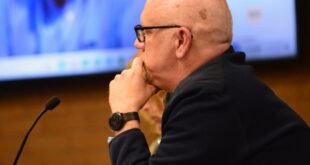
The attorney for the developer of a proposed 21,000-square-foot temple slated for South Middlebush Road said August 5 that the building’s design will probably be changed.
Attorney Peter Lanfrit told the Zoning Board of Adjustment that so many alterations have been made to the original plan, his client would have to come before the Board with a modified plan before final site plan approval could be granted.
Lanfrit’s announcement was in reply to a comment by Mark Healey, the township’s principal planner, about whether there were religious constraints on the building’s design, and by an objecting expert who testified that the proposed building design did not mesh with its surroundings.
“We have to come back for a final site plan approval,” Lanfrit said. “I can talk to my architect and client as to whether the architecture can be changed somewhat. We do have to come back with new design even if we get preliminary approval.”
The preliminary approvals Lanfrit will be seeking are for use variances and bulk variances.
Lanfrit said earlier that the applicant, the Dada Bhagwan Vignan Institute, is bound by religious tenets to paint the front of the building white. The rest of the building, he said, could be painted in Earth tones, as was requested by a neighboring property owner.
How the building will look comprised a good part of teh testimony offered by another planner, Michael Kauker, who testified for neighbors opposing the plan.
Also testifying for the opposition during the hearing was Susan Quackenbush, an environmental expert, who spoke about the possibility of endangered bat and bird species habitats being destroyed by the planned tree clearing, and a possible stream on an adjoining property that would require a 300-foot buffer.
The August 5 hearing was the ninth for the proposed temple, targeted for a tract of land abutting the Snyder’s Farm.
Kauker’s testimony focused on how the 21,000-square-foot, 30-foot tall temple would change the character of the area. He contended that the temple would be visible from South Middlebush Road, and that the white exterior walls would make it stand out even more.
“One of the concerns I had as a planner is the suitability in this area,” he said.
“We are in the middle of a scenic corridor,” he said. “It’s a fairly large building, but I think in terms of the impact, I think a building that massive would be seen from Middlebush Road.”
Kauker said that planners like to have consistency in architectural design in areas.
“In my opinion, I believe that this proposed development is going to be inconsistent with the scenic corridor,” he said.
During his cross-examination, Lanfrit pointed out that teh applicant was bound by his religion to paint the front wall white. He also questioned whether the temple would be seen by drivers traveling northbound on South Middlebush.
“You’re telling this Board that if I were in a vehicle driving on South Middlebush Road driving toward the municipal building, you would be able to see that building?” Lanfrit asked.
“I believer so,” Kauker said.
“That building is a one-storey building, is it not?” Lanfrit asked.
“It’s a one-storey building, but its a 30-foot-tall one-storey building,” Kauker said.
Lanfrit’s contention that the temple would noyt be seen by some drivers on South Middlebush Road was backed up by Healey.
“I can’t imagine any potential visibility of this building going northbound on South Middlebush,” he said. “It is well in excess of 1,000 feet away, there are two intervening homes, you have an intervening township-owned forested open space site. Absent somebody getting out of their car and staring through the woods and really trying to see this site, I don’t see how this can be visible driving north bound.”
Board chairman Robert Thomas agreed.
“There is no one, I would venture to say, who is going to see this structure going south to north,” he said. “Not going to happen.”
Quackenbush told the Board that trees located in the targeted tract, which could be cleared for construction, may be habitats for two endangered species: the Indiana and Northern Longhair bats.
Quackenbush said she came to that opinion based on photographs taken of teh trees in the area and data from the U.S. Fish & Wildlife Service.
“These bat species are really dependent on trees, primarily trees that have flaking, peeling bark where they can roost during summer months,” she said. “I saw mature trees present with peeling bark that could provide habitat for these bat species.”
“We would recommend a full habitat assessment be done … to confirm that the project will not adversely affect bats,” she said.
She said that data from the U.S. Fish & Wildlife Service also shows several species of endangered birds in the area.
Quackenbush also said that a picture of what appears to be a stream channel on township-owned property, just to the south of the temple tract, also needs further study.
The environmental assessment prepared by the applicant does not show any stream on the property, she said. But soil survey maps show “a small headwater area that definitely has evidence of water flow, and may also have a discernible channel.”
Quackenbush said that for $1,000, the applicant could get a study from the state Department of Environmental Protection to determine if that area should be regulated by teh agency.
“If it is regulated, it is subject to a riparian zone and because this feature drains to the Nine Mile Run, it would be considered Category 1 and afforded the widest riparian zone, and that is 300 feet, measured from the top of its bank,” she said.
She said if that was the case, the buffer would extend onto teh temple property.
Lanfrit focused on Quackenbush’s admission that she did not visit the site, but relied on photos and information given to her.
“You do not know whether there s a habitat for bat species on this property, nor did you ever observe whether there are any bats on this property,” he said.
“I have seen photos of trees that are consistent with bat habitat,” Quackenbush said.
Lanfrit pointed out that the temple would only clear trees during periods approved by the township.
The attorney also asked about the buffer that might be required if a stream were detected on the adjoining property.
“If we apply the 300 foot buffer … is any of the proposed development by the applicant within that 300 foot buffer?” he asked.
“No, it is approximately 23 feet away,” she said.
“What you’re saying is there is nothing being done on this property that is environmentally unsound,” Thomas interjected. “Is that correct?”
Quackenbush told Thomas that the mapping tools used were not “survey grade.”
“So far, we’re taking about endangered species on this property that no one has ever seen, and we’re talking about environmental impacts that are not on this property,” Thomas said. “It might have been better if we had some boots on the ground on this property, and were not just looking at some photos and reports and GIS information.”
When Quackenbush replied that going on the temple’s property would be trespassing, Thomas asked Lanfrit if his applicant would have allowed them on their land.
“I assume she would have been welcomed on the property,” Lanfrit said.
“It’s a little hard for me to embrace a report like this when you tell me that you haven’t even visited the site,” Thomas said. “I just don’t get it.”
Board member Gary Rosenthal agreed.
“I question this entire testimony because this person has not seen this property,” he said.
The next hearing on the application is set for the Board’s September 2 meeting.
 The Franklin Reporter & Advocate Eight Villages, One Community
The Franklin Reporter & Advocate Eight Villages, One Community

